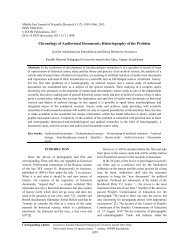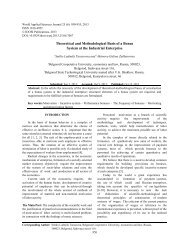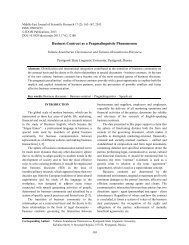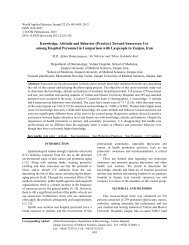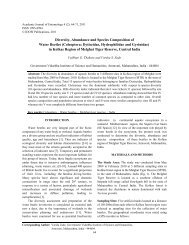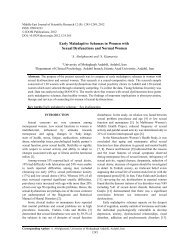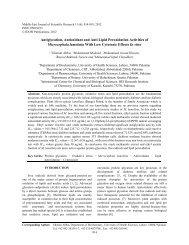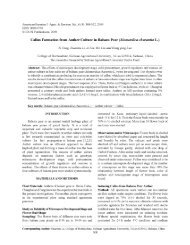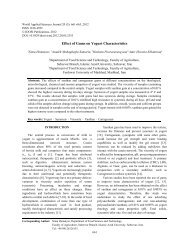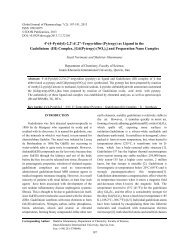Antimicrobial Activity of Some Important Medicinal Plant ... - Idosi.org
Antimicrobial Activity of Some Important Medicinal Plant ... - Idosi.org
Antimicrobial Activity of Some Important Medicinal Plant ... - Idosi.org
You also want an ePaper? Increase the reach of your titles
YUMPU automatically turns print PDFs into web optimized ePapers that Google loves.
World J. Agric. Sci., 4 (S): 839-843, 2008<br />
systematic investigation was undertaken to screen the the thimble and extracted successively with methanol<br />
local flora for antibacterial and antifungal activity from solvent in Soxhlet extractor for 48h. The solvent extracts<br />
Acacia nilotica, Sida cordifolia, Tinospora cordifolia, were concentrated under reduced pressure and preserved<br />
Ziziphus mauritiana and Withania somnifera. The at 5°C in airtight bottle until further use.<br />
Acacia nilotica (L.) Willd. belongs to the family<br />
Mimosaceae. Decoction <strong>of</strong> bark is used as gargle and <strong>of</strong> Growth and Maintenance <strong>of</strong> Test Micro<strong>org</strong>anism for<br />
pods in urino-genital diseases. Sida cordifolia L. <strong>Antimicrobial</strong> Studies: Bacterial cultures <strong>of</strong><br />
(Malvaceae) root is used in pain, nervous disorders, Bacillus subtilis (B. subtilis), Escherichia coli (E. coli),<br />
coryza, cardiac diseases. The stem <strong>of</strong> Tinospora Pseudomonas fluorescens (P. fluorescens),<br />
cordifolia (Wild.) Hk.f. & Th. which belongs to the family Staphylococcus aureus (S. aureus) and Xanthomonas<br />
Menispermaceae is used as an ingredient for Ayurvedic axonopodis pv. malvacearum (X. axonopodis pv.<br />
preparations used in general debility, dyspepsia, fevers malvacearum) and fungal cultures <strong>of</strong> Aspergillus flavus<br />
and urinary diseases. Root is a powerful emetic and used (A. flavus), Dreschlera turcica (D. turcica) and<br />
for visceral obstruction; its watery extracts is used in Fusarium verticillioides (F. verticillioides), were<br />
leprosy. Withania somnifera (L.) Dunal which belong to obtained from the culture collection centre, Department <strong>of</strong><br />
the family Solanaceae is used in hiccup, cough, dropsy, Applied Botany and Biotechnology, University <strong>of</strong><br />
rheumatism and gynaecological disorders an as a sedative Mysore, India, were used for antimicrobial test <strong>org</strong>anisms.<br />
in senile debility. It is also useful in inflammatory The bacteria were maintained on nutrient broth (NB) at<br />
conditions, ulcers and scabies as external application. 37°C and fungus were maintained on Potato dextrose agar<br />
Leaves used as a febrifuge and applied to lesions painful<br />
swellings and sore eyes. Ziziphus mauritiana Lam.<br />
(PDA) at 28°C.<br />
Belongs to the family Rhamnaceae. The fruits used Preparation <strong>of</strong> Inoculum: The gram positive<br />
anodyne and tonic. They form one <strong>of</strong> the ingredients <strong>of</strong> (Bacillus subtilis and Staphylococcus aureus) and gram<br />
Joshanda, a medicine used in chest troubles. Kernels negative bacteria (Escherichia coli, Pseudomonas<br />
sedative, used as soporific and to stop vomiting; also fluorescens and Xanthomonas axonopodis pv.<br />
employed as an antidote to aconite-poisoning and in malvacearum) were pre-cultured in nutrient broth<br />
abdominal pains. Seeds are given in diarrhea. Leaves with overnight in a rotary shaker at 37°C, centrifuged at 10,000<br />
catechu (Areca catechu) used as an astringent and rpm for 5 min, pellet was suspended in double distilled<br />
considered diaphoretic. [9]. water and the cell density was standardized<br />
MATERIALS AND METHODS<br />
spectrophotometrically (A 610 nm). The fungal inoculum<br />
(F. verticillioides, D. turcica and A. flavus) was<br />
prepared from 5 to 10 day old culture grown on Potato<br />
Collection <strong>of</strong> <strong>Plant</strong> Material: Fresh leaves bark and root dextrose agar medium. The Petri dishes were flooded with<br />
<strong>of</strong> five different plants viz., Acacia nilotica(L.) Willd., 8 to 10 ml <strong>of</strong> distilled water and the conidia were scraped<br />
Sida cordifolia L., Tinospora cordifolia (Wild.) using sterile spatula. The spore density <strong>of</strong> each fungus<br />
Hk.f. & Th., Withania somnifera (L.) Dunal and was adjusted with spectrophotometer (A595 nm) to<br />
Ziziphus mauritian Lam. free from disease were collected<br />
5<br />
obtain a final concentration <strong>of</strong> approximately 10<br />
from Mysore and Nanjangud, Karnataka. The leaves were<br />
washed thoroughly 2-3 times with running water and once<br />
spores/ml.<br />
with sterile distilled water, leaf, bark and root material was Anti-bacterial <strong>Activity</strong>: The methanol leaf extracts <strong>of</strong><br />
then air-dried on sterile blotter under shade. Acacia nilotica, Sida cordifolia Tinospora cordifolia,<br />
Withania somnifera and Ziziphus mauritian, bark extract<br />
Solvent Extraction: Thoroughly washed dried leaves <strong>of</strong> <strong>of</strong> Acacia nilotica Tinospora cordifolia and Ziziphus<br />
five plants <strong>of</strong> Acacia nilotica, Sida cordifolia Tinospora mauritian and root extract <strong>of</strong> Sida cordifolia and<br />
cordifolia, Withania somnifera and Ziziphus mauritian, Withania somnifera were tested by the disc diffusion<br />
bark extract <strong>of</strong> Acacia nilotica Tinospora cordifolia and method [10]. Different concentration <strong>of</strong> the extracts<br />
Ziziphus mauritian and root extract <strong>of</strong> Sida cordifolia (100 µg ml<br />
1<br />
) was prepared by reconstituting with<br />
and Withania somnifera <strong>of</strong> plant material were dried in methanol. The test micro<strong>org</strong>anisms were seeded into<br />
shade for five days and then powdered with the help <strong>of</strong> respective medium by spread plate method 10 µl<br />
Waring blender. 25 g <strong>of</strong> shade-dried powder was filled in<br />
6<br />
(10 cells/ml) with the 24h cultures <strong>of</strong> bacteria growth in<br />
840



